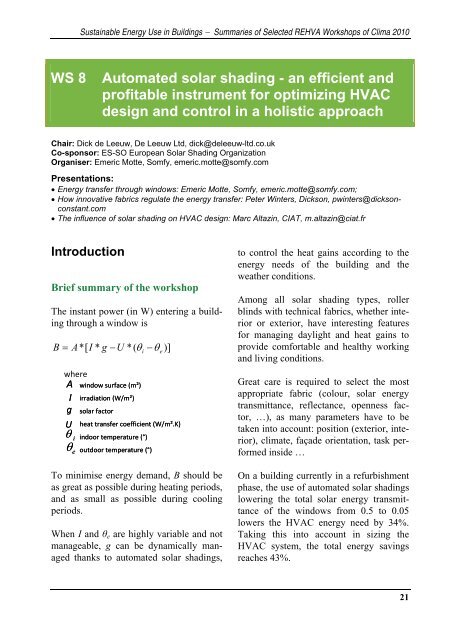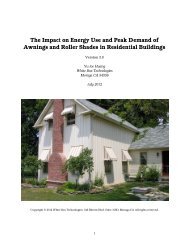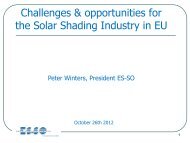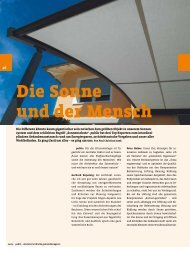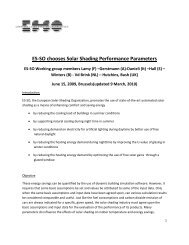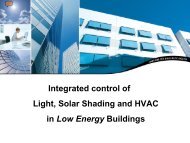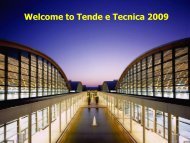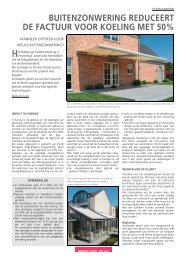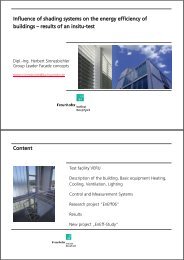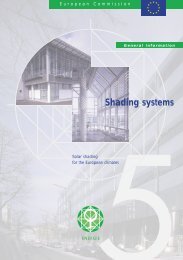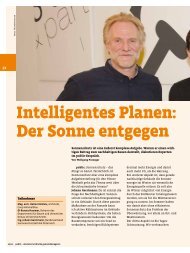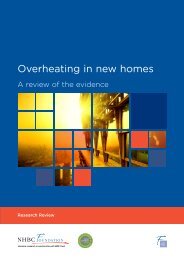WS 8 Automated solar shading - an efficient and profitable ... - ES-SO
WS 8 Automated solar shading - an efficient and profitable ... - ES-SO
WS 8 Automated solar shading - an efficient and profitable ... - ES-SO
Create successful ePaper yourself
Turn your PDF publications into a flip-book with our unique Google optimized e-Paper software.
Sustainable Energy Use in Buildings − Summaries of Selected REHVA Workshops of Clima 2010<br />
<strong>WS</strong> 8 <strong>Automated</strong> <strong>solar</strong> <strong>shading</strong> - <strong>an</strong> <strong>efficient</strong> <strong>an</strong>d<br />
<strong>profitable</strong> instrument for optimizing HVAC<br />
design <strong>an</strong>d control in a holistic approach<br />
Chair: Dick de Leeuw, De Leeuw Ltd, dick@deleeuw-ltd.co.uk<br />
Co-sponsor: <strong>ES</strong>-<strong>SO</strong> Europe<strong>an</strong> Solar Shading Org<strong>an</strong>ization<br />
Org<strong>an</strong>iser: Emeric Motte, Somfy, emeric.motte@somfy.com<br />
Presentations:<br />
• Energy tr<strong>an</strong>sfer through windows: Emeric Motte, Somfy, emeric.motte@somfy.com;<br />
• How innovative fabrics regulate the energy tr<strong>an</strong>sfer: Peter Winters, Dickson, pwinters@dicksonconst<strong>an</strong>t.com<br />
• The influence of <strong>solar</strong> <strong>shading</strong> on HVAC design: Marc Altazin, CIAT, m.altazin@ciat.fr<br />
Introduction<br />
Brief summary of the workshop<br />
The inst<strong>an</strong>t power (in W) entering a building<br />
through a window is<br />
B = A*<br />
[ I * g −U<br />
* ( θ i −θ<br />
e )]<br />
where<br />
A<br />
I<br />
g<br />
U<br />
θθ<br />
i<br />
θθ<br />
window surface (m²)<br />
irradiation (W/m²)<br />
<strong>solar</strong> factor<br />
heat tr<strong>an</strong>sfer co<strong>efficient</strong> (W/m².K)<br />
indoor temperature (°)<br />
e outdoor temperature (°)<br />
To minimise energy dem<strong>an</strong>d, B should be<br />
as great as possible during heating periods,<br />
<strong>an</strong>d as small as possible during cooling<br />
periods.<br />
When I <strong>an</strong>d θe are highly variable <strong>an</strong>d not<br />
m<strong>an</strong>ageable, g c<strong>an</strong> be dynamically m<strong>an</strong>aged<br />
th<strong>an</strong>ks to automated <strong>solar</strong> <strong>shading</strong>s,<br />
to control the heat gains according to the<br />
energy needs of the building <strong>an</strong>d the<br />
weather conditions.<br />
Among all <strong>solar</strong> <strong>shading</strong> types, roller<br />
blinds with technical fabrics, whether interior<br />
or exterior, have interesting features<br />
for m<strong>an</strong>aging daylight <strong>an</strong>d heat gains to<br />
provide comfortable <strong>an</strong>d healthy working<br />
<strong>an</strong>d living conditions.<br />
Great care is required to select the most<br />
appropriate fabric (colour, <strong>solar</strong> energy<br />
tr<strong>an</strong>smitt<strong>an</strong>ce, reflect<strong>an</strong>ce, openness factor,<br />
…), as m<strong>an</strong>y parameters have to be<br />
taken into account: position (exterior, interior),<br />
climate, façade orientation, task performed<br />
inside …<br />
On a building currently in a refurbishment<br />
phase, the use of automated <strong>solar</strong> <strong>shading</strong>s<br />
lowering the total <strong>solar</strong> energy tr<strong>an</strong>smitt<strong>an</strong>ce<br />
of the windows from 0.5 to 0.05<br />
lowers the HVAC energy need by 34%.<br />
Taking this into account in sizing the<br />
HVAC system, the total energy savings<br />
reaches 43%.<br />
21
Sustainable Energy Use in Buildings − Summaries of Selected REHVA Workshops of Clima 2010<br />
22<br />
kWH / Yr<br />
Light tr<strong>an</strong>smission co<strong>efficient</strong> of a window without/ with exterior/with interior roller blind:<br />
no impact of the position of the blind vs. the glass p<strong>an</strong>es.<br />
Total <strong>solar</strong> energy tr<strong>an</strong>smission co<strong>efficient</strong> without / with exterior/with interior roller blind:<br />
high import<strong>an</strong>ce of the position of the blind (fabric type has to be selected according to position).<br />
Energy need of a building in<br />
3 different configurations:<br />
- windows with a total <strong>solar</strong> energy<br />
tr<strong>an</strong>smission co<strong>efficient</strong> of 0.50 +<br />
CIAT system ILD150<br />
- windows with a total <strong>solar</strong> energy<br />
tr<strong>an</strong>smission co<strong>efficient</strong> of 0.05 (with<br />
roller blinds) + CIAT syst. ILD150<br />
- windows with a total <strong>solar</strong> energy<br />
tr<strong>an</strong>smission co<strong>efficient</strong> of 0.05 (with<br />
roller blinds) + HVAC optimization
Sustainable Energy Use in Buildings − Summaries of Selected REHVA Workshops of Clima 2010<br />
Discussions<br />
1. Although attendees acknowledge the<br />
impact of automated <strong>solar</strong> <strong>shading</strong> on the<br />
energy perform<strong>an</strong>ce of buildings, they<br />
plead for more information on:<br />
• Available types of <strong>solar</strong> <strong>shading</strong>s<br />
Solar <strong>shading</strong> m<strong>an</strong>ufacturers market a wide<br />
r<strong>an</strong>ge of products, with lifting or lifting- <strong>an</strong>d<br />
tilting capacity, which cope with architectural,<br />
aesthetical, climatic <strong>an</strong>d lifestyle conditions.<br />
These products have different thermal<br />
<strong>an</strong>d visual perform<strong>an</strong>ces which need to<br />
be differentiated to decision makers.<br />
• integration of <strong>solar</strong> <strong>shading</strong>s info façades<br />
Specially for double skin facades <strong>an</strong>d<br />
closed cavity facades, information should<br />
be given by m<strong>an</strong>ufacturers on space requirements<br />
(for the headrail / box of the<br />
<strong>shading</strong> device), temperature limitations.<br />
• <strong>solar</strong> <strong>shading</strong>s control strategies<br />
What are the most st<strong>an</strong>dard control strategies,<br />
what types of sensors are required.<br />
These data may be specific to m<strong>an</strong>ufacturers,<br />
who may not be the <strong>solar</strong> <strong>shading</strong><br />
m<strong>an</strong>ufacturers.<br />
• integration of <strong>solar</strong> <strong>shading</strong> controls<br />
into Building M<strong>an</strong>agement Systems<br />
Due to different biding processes, controls<br />
may sometimes be integrated into the façade<br />
lot; in that case the HVAC/BMS lot<br />
may not get enough information on the<br />
controls systems which have been required,<br />
or the HVAC/BMS comp<strong>an</strong>ies<br />
may not be able to specify the technology<br />
of the shades controls.<br />
2. <strong>Automated</strong> <strong>solar</strong> <strong>shading</strong>s are seldom<br />
taken into account in energy perform<strong>an</strong>ce<br />
calculations due to:<br />
• input values for calculation, as described<br />
in point 1, are not always available.<br />
• most available energy calculation<br />
software do not take into account<br />
dynamic <strong>solar</strong> <strong>shading</strong>s<br />
The position of the <strong>shading</strong> device has <strong>an</strong><br />
impact on the g-tot (total <strong>solar</strong> energy<br />
tr<strong>an</strong>smitt<strong>an</strong>ce) <strong>an</strong>d the U-value (heat tr<strong>an</strong>sfer<br />
co<strong>efficient</strong>) of the window. g-tot may<br />
vary in a 10:1 ratio, U-value may vary by<br />
0.2 between the up (open) <strong>an</strong>d down<br />
(close) positions.<br />
Reasons not to take dynamic <strong>solar</strong> <strong>shading</strong><br />
into account c<strong>an</strong> be:<br />
• m<strong>an</strong>y software simulate on a monthstep<br />
basis which makes it difficult to<br />
take <strong>solar</strong> gains into consideration, this<br />
is more relev<strong>an</strong>t when simulations are<br />
made on <strong>an</strong> hour-step basis (like in<br />
French RT2005 <strong>an</strong>d RT2012)<br />
• the way to calculate g-tot is detailed in<br />
EN 13363-1 <strong>an</strong>d EN 13363-2 <strong>an</strong>d<br />
might be complex, specially with Veneti<strong>an</strong><br />
blinds.<br />
• wind dependency of perform<strong>an</strong>ce of<br />
exterior <strong>solar</strong> <strong>shading</strong>s<br />
The use of exterior <strong>shading</strong> devices is limited<br />
by weather conditions, such as wind, rain,<br />
icing etc. In those situations the <strong>shading</strong> devices<br />
are blocked in their upper position <strong>an</strong>d<br />
c<strong>an</strong>'t contribute to the energy perform<strong>an</strong>ce.<br />
23
Sustainable Energy Use in Buildings − Summaries of Selected REHVA Workshops of Clima 2010<br />
The shade industry has already developed<br />
wind-resist<strong>an</strong>t <strong>shading</strong> devices, <strong>an</strong>d has to<br />
carry on its efforts in that direction.<br />
• although some components have a 5year<br />
warr<strong>an</strong>tee, most of the complete<br />
<strong>solar</strong> <strong>shading</strong> products are sold with a 2year<br />
warr<strong>an</strong>tee<br />
Most of the technical equipments of buildings<br />
have a 5-year warr<strong>an</strong>tee, whereas<br />
most of the <strong>shading</strong> devices are delivered<br />
with a 2-year warr<strong>an</strong>tee, they c<strong>an</strong>'t therefore<br />
be considered as building equipments.<br />
• no mainten<strong>an</strong>ce budget to guar<strong>an</strong>tee the<br />
perform<strong>an</strong>ce over time<br />
Not being considered as technical equipments,<br />
there is no mainten<strong>an</strong>ce budget to<br />
maintain their good functioning, thus their<br />
contribution to the energy perform<strong>an</strong>ce<br />
c<strong>an</strong>not be guar<strong>an</strong>teed.<br />
• due to items d <strong>an</strong>d e, the selection of<br />
<strong>solar</strong> <strong>shading</strong> devices is too often left to<br />
the interior architect/designer<br />
3. Although there is a benefit in right sizing<br />
the HVAC system, HVAC engineers are<br />
reluct<strong>an</strong>t to do so<br />
• they have to guar<strong>an</strong>tee good<br />
working/living conditions for the<br />
occup<strong>an</strong>ts all year round<br />
Whatever the real time weather, which is<br />
different (<strong>an</strong>d may be very different) from<br />
the meteorological weather database.<br />
Actual occup<strong>an</strong>cy, thus internal heat gains,<br />
may also be different from what has been<br />
originally defined.<br />
24<br />
• thus they have to take into account<br />
potential defaults of the building<br />
envelope linked to improper installation<br />
of façade components<br />
Air-tightness <strong>an</strong>d U-value of the envelope<br />
may be affected by construction defaults,<br />
thus actual energy needs may differ from<br />
what is calculated.<br />
4. Impact of <strong>solar</strong> <strong>shading</strong> on lighting<br />
energy consumption is not well known<br />
<strong>an</strong>d valued<br />
Daylighting autonomy, i.e. amount of daylight<br />
over time, is a major concern for<br />
building designers as a source of potential<br />
huge energy savings. The highest it is, the<br />
less artificial lighting is necessary.<br />
It depends on m<strong>an</strong>y factors, such as window<br />
size, place of the window in the façade, room<br />
dimensions, reflection factor of the walls <strong>an</strong>d<br />
the light tr<strong>an</strong>smission factor of the window.<br />
When there is a dynamic <strong>solar</strong> <strong>shading</strong> device,<br />
this one modifies the light tr<strong>an</strong>smission<br />
of the glass, thus the daylighting autonomy,<br />
thus the complementary lighting necessary to<br />
provide sufficient illumin<strong>an</strong>ce in the room.<br />
The Daylight Factor DF is<br />
a percentage ratio of the inst<strong>an</strong>t<strong>an</strong>eous<br />
illumination level at a reference point<br />
inside a room to that occurring simult<strong>an</strong>eously<br />
outside in <strong>an</strong> unobstructed position.
Sustainable Energy Use in Buildings − Summaries of Selected REHVA Workshops of Clima 2010<br />
Conclusions <strong>an</strong>d future<br />
work directions in the field<br />
1. At Clima 2010, REHVA <strong>an</strong>d<br />
<strong>ES</strong>-<strong>SO</strong> (Europe<strong>an</strong> Solar Shading<br />
Org<strong>an</strong>ization) introduced a new<br />
REHVA GUIDEBOOK No 12:<br />
“Solar Shading<br />
– How to integrate <strong>solar</strong> <strong>shading</strong> in<br />
sustainable buildings”<br />
REHVA GUIDEBOOK No 12<br />
“Solar Shading” provides<br />
extensive information on<br />
• effect of windows on the indoor environment<br />
• window systems<br />
• energy effects of <strong>solar</strong> <strong>shading</strong><br />
• how to choose a <strong>solar</strong> <strong>shading</strong> solution<br />
• automating <strong>an</strong>d integrating <strong>solar</strong> <strong>shading</strong><br />
• retroffiting windows <strong>an</strong>d <strong>solar</strong> <strong>shading</strong>s<br />
• double-skin façades<br />
• mainten<strong>an</strong>ce of <strong>solar</strong> <strong>shading</strong> systems.<br />
2. In addition, <strong>ES</strong>-<strong>SO</strong> has to work on<br />
case studies <strong>an</strong>d communicate on best<br />
practice to comfort the HVAC<br />
industry of the benefits of automated<br />
<strong>solar</strong> <strong>shading</strong>s.<br />
3. <strong>ES</strong>-<strong>SO</strong> <strong>an</strong>d their members have to<br />
intensify their work to improve their<br />
knowledge on the impact on lighting<br />
<strong>an</strong>d communicate the results to the<br />
HVAC industry.<br />
REHVA <strong>an</strong>d <strong>ES</strong>-<strong>SO</strong> have to join efforts to spread this document as widely as possible.<br />
<strong>ES</strong>-<strong>SO</strong> is also involved in research programs, like Keep Cool (www.keep-cool.eu) <strong>an</strong>d<br />
ASIEPI (www.asiepi.eu) in which additional relev<strong>an</strong>t information is available.<br />
Ordering information:<br />
Contact REHVA office in Brussels:<br />
Tel: +32-2-5141171 or send <strong>an</strong> email to: sales@rehva.eu<br />
or order the Guidebook online at REHVA bookstore at www.rehva.eu<br />
25


